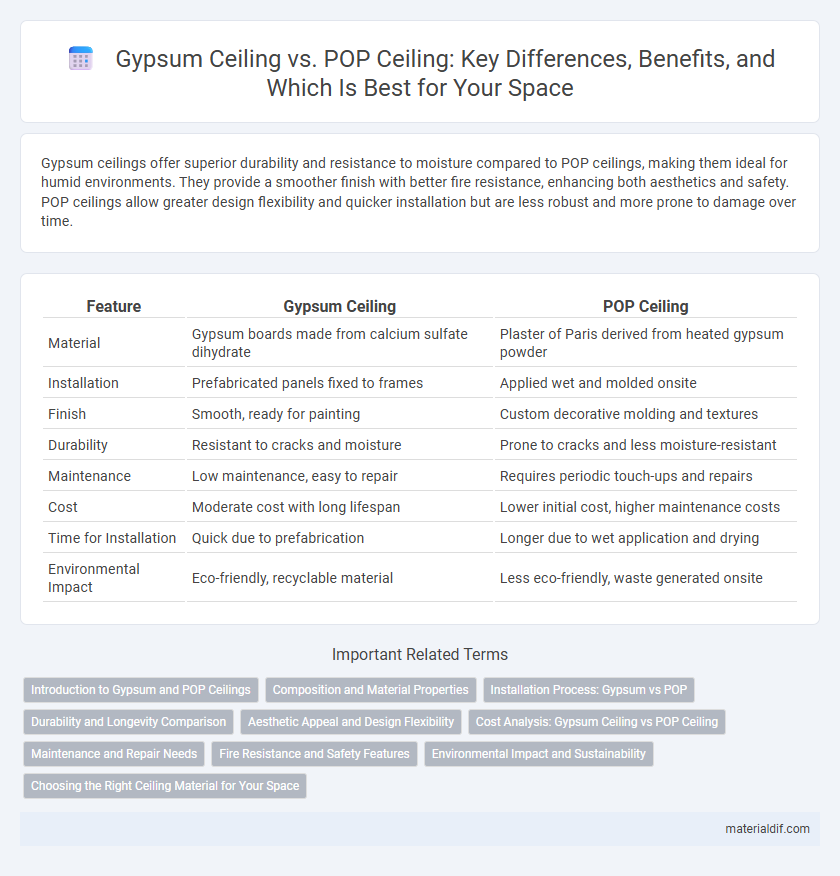Gypsum ceilings offer superior durability and resistance to moisture compared to POP ceilings, making them ideal for humid environments. They provide a smoother finish with better fire resistance, enhancing both aesthetics and safety. POP ceilings allow greater design flexibility and quicker installation but are less robust and more prone to damage over time.
Table of Comparison
| Feature | Gypsum Ceiling | POP Ceiling |
|---|---|---|
| Material | Gypsum boards made from calcium sulfate dihydrate | Plaster of Paris derived from heated gypsum powder |
| Installation | Prefabricated panels fixed to frames | Applied wet and molded onsite |
| Finish | Smooth, ready for painting | Custom decorative molding and textures |
| Durability | Resistant to cracks and moisture | Prone to cracks and less moisture-resistant |
| Maintenance | Low maintenance, easy to repair | Requires periodic touch-ups and repairs |
| Cost | Moderate cost with long lifespan | Lower initial cost, higher maintenance costs |
| Time for Installation | Quick due to prefabrication | Longer due to wet application and drying |
| Environmental Impact | Eco-friendly, recyclable material | Less eco-friendly, waste generated onsite |
Introduction to Gypsum and POP Ceilings
Gypsum ceilings are made from natural mineral gypsum, offering fire resistance, durability, and smooth finishes ideal for modern interiors. POP (Plaster of Paris) ceilings use a quick-setting material derived from heated gypsum powder, favored for intricate designs and cost-effectiveness. Both materials provide lightweight, versatile ceiling solutions, but gypsum panels typically ensure better moisture resistance and longevity compared to traditional POP ceilings.
Composition and Material Properties
Gypsum ceilings consist primarily of natural gypsum mineral, CaSO4*2H2O, offering excellent fire resistance, moisture regulation, and sound insulation due to their dense crystalline structure. POP (Plaster of Paris) ceilings are made from calcined gypsum powder, rehydrated to form a smooth, quick-setting paste that allows intricate designs but lacks the inherent moisture resistance of natural gypsum boards. The key difference lies in gypsum ceilings' durability and moisture control versus POP's ease of molding and finishing versatility.
Installation Process: Gypsum vs POP
Gypsum ceiling installation involves fixing pre-fabricated gypsum boards onto a metal framework with screws, offering a cleaner and faster setup compared to POP ceilings, which require a labor-intensive process of applying wet plaster, shaping, and drying. The gypsum method reduces dust and mess, allowing quicker project completion and easier maintenance. POP ceilings need skilled artisans to sculpt intricate designs but involve longer drying times and higher chances of cracks during installation.
Durability and Longevity Comparison
Gypsum ceilings offer superior durability compared to POP ceilings due to their resistance to cracks, moisture, and fire, extending the lifespan of interior spaces. Unlike POP ceilings, which are prone to chipping and require frequent maintenance, gypsum ceilings maintain structural integrity for over 15 years with minimal upkeep. The enhanced longevity of gypsum ceilings makes them a cost-effective and reliable choice for long-term interior finishing solutions.
Aesthetic Appeal and Design Flexibility
Gypsum ceilings offer a smooth, seamless finish with intricate design capabilities, allowing for elegant curves and detailed molding that enhance the aesthetic appeal of any space. POP (Plaster of Paris) ceilings, while versatile, often lack the refined texture and precision achievable with gypsum, resulting in a less polished look. Gypsum's superior design flexibility supports contemporary styles and complex patterns, making it ideal for innovative interior design projects.
Cost Analysis: Gypsum Ceiling vs POP Ceiling
Gypsum ceilings generally offer a higher initial cost compared to POP ceilings due to material expenses and installation complexity, but they provide superior durability and require less maintenance over time, which can reduce long-term costs. POP ceilings are more budget-friendly upfront and easier to mold into intricate designs, making them popular for aesthetic purposes in residential projects with limited budgets. However, POP ceilings tend to be more prone to cracks and moisture damage, potentially increasing repair costs in humid environments compared to gypsum ceilings.
Maintenance and Repair Needs
Gypsum ceilings offer superior durability and require less frequent maintenance compared to POP ceilings, which are more prone to cracks and water damage. Gypsum's moisture-resistant properties make it easier to clean and repair, reducing long-term upkeep costs. POP ceilings often demand regular repainting and patching, increasing their maintenance and repair needs over time.
Fire Resistance and Safety Features
Gypsum ceilings offer superior fire resistance due to their non-combustible nature and high thermal insulation properties, effectively limiting fire spread and providing valuable time during emergencies. POP ceilings, composed primarily of Plaster of Paris, have lower fire resistance and can deteriorate rapidly under intense heat, compromising structural safety. The enhanced fire safety of gypsum ceilings makes them a preferred choice in residential and commercial buildings requiring stringent fire protection standards.
Environmental Impact and Sustainability
Gypsum ceilings are more environmentally sustainable due to their natural composition and lower carbon footprint compared to POP ceilings, which involve synthetic chemicals and higher energy consumption during production. Gypsum panels are recyclable and contribute less to indoor air pollution, enhancing indoor air quality. The biodegradability and energy-efficient manufacturing process make gypsum a preferable choice for eco-friendly ceiling solutions.
Choosing the Right Ceiling Material for Your Space
Gypsum ceilings offer superior fire resistance and durability compared to POP ceilings, making them ideal for long-term installations in commercial and residential spaces. POP ceilings, while cost-effective and easier to mold into intricate designs, lack the moisture resistance and longevity of gypsum. Selecting the right ceiling material depends on factors such as budget, design preferences, and environmental conditions influencing durability and maintenance.
Gypsum ceiling vs POP ceiling Infographic

 materialdif.com
materialdif.com